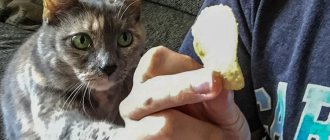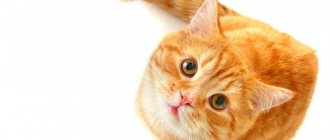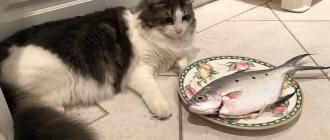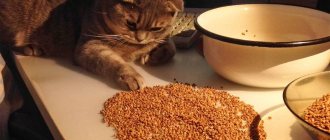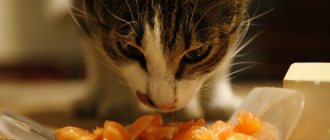Cats are true carnivores. Meat is a necessary main ingredient in their diet. What about fruit - are they safe for cats? And if so, what fruits can cats eat?
Due to the lack of sweet taste receptors, cats are usually not interested in the sweetness of fruits. However, there are several types of fruits that cats can eat in moderation as treats. A few bites is all their digestive system can handle.
Check out our list of safe fruits for cats.
How much fruit can a cat eat?
Limit the amount of fruit and other treats to no more than 2% of your cat's diet. Fruit is best given as an alternative to cat treats, especially when weight loss is desired. They can be offered as fresh or frozen treats cut into small pieces. They should be fed separately from regular pet food.
If your cat cannot digest fruit comfortably, you may see signs of indigestion (stomach upset) such as vomiting, diarrhea, or constipation. Due to the high sugar content, diabetic cats should not be given fruit.
Do they eat?
Like other animals, cats need plant foods. If it is not in the diet, then the pet can eat indoor plants in the house. Cats eat grass, as well as some vegetables and fruits, because... need additional sources of minerals, vitamins and nutrients.
One of the most common fruits is apples. Owners are interested in whether it is possible to include it in the pet’s menu, how often to offer the fruit, and what effect it will have. To answer these questions, you need to study the composition and properties of apples .
Benefit
Apples are widely known for their beneficial properties. They contain the following elements:
- vitamins A, E, C, K, B4, B9;
- calcium;
- potassium;
- magnesium;
- fluorine;
- iron;
- organic acids;
- tannins;
- cellulose.
The peel of the fruit is rich in pectin, and the seeds are rich in iodine. Periodic consumption of apples can strengthen the cat’s immune system and protect against frequent colds caused by viruses and bacteria. Pets with weak immunity are susceptible to lichen and other skin infections, and have a weakened muscular system.
B vitamins restore the nervous system, improve digestion, and the appearance of the animal’s skin and coat. Thanks to them, microcracks and wounds on the body heal and heal faster, and inflammatory processes stop. Vitamin A makes the coat shiny and preserves vision, normalizes kidney function.
The presence of biotin and vitamin H improves metabolic processes in tissues and the structure of the coat. The substances contained in apples are able to protect cells from the negative effects of free radicals, which provoke the appearance of malignant tumors.
Potassium is especially necessary for older cats, because... it can improve the functioning of the kidneys, liver and urinary system as a whole. The element also restores water balance and plays an important role in the production of various enzymes. Calcium helps keep your animal's bones, teeth and claws strong.
Harm
Although the benefits of apples for a cat’s body are undeniable, there are cases when they can harm the animal.
If the daily portion of the product is exceeded, due to the ingestion of a large amount of fiber, the cat may experience diarrhea, and in some cases colitis. It is recommended to exclude apples from the diet of a pet who suffers from stomach problems, because... they can provoke pain in the gastrointestinal tract.
When preparing a dish from apples, you need to carefully ensure that the seeds do not get into it. The latter are rich in iodine and can cause rash, nausea, vomiting and diarrhea. In addition, they contain dangerous hydrocyanic acid, which is a strong toxic substance. If it enters a cat's body, it can be fatal.
What other foods are safe for cats?
Your cat can also eat these foods safely and in moderation. Be sure to remove all seeds, stems, pits/cores and skins:
- Artichokes
- Asparagus
- Beans
- Broccoli
- Cabbage
- Carrots (cut into small pieces to avoid choking)
- Cauliflower
- Celery (cut into small pieces to avoid choking)
- Coconut
- Eggplant
- Ginger
- green bean
- lettuce
- Olives
- Peas
- Pepper
- Pumpkin (avoid seeds, stems, seeds, peel)
- Sweet potato
- Winter squash (avoid seeds, stems, seeds, peel)
Why does he chew or lick the bag?
The main reason why a cat chews apples is an unbalanced diet. In addition to these fruits, the animal can eat grass, indoor plants or other vegetables and fruits.
Representatives of felines in the wild consume not only animal, but also plant foods. This is due to the fact that cats need coarse plant fibers. They improve digestive processes and saturate the body with essential vitamins. Thus, the pet, gnawing apples, simply tries to replenish the missing minerals and elements.
Most often, this problem can occur if the cat is fed food from the table. Human food is not entirely healthy for pets. Cheap food (Whiskas, Kitekat) is also harmful. It contains no vitamins and minerals, and even no meat (replaced with bone meal and food industry waste).
In this case, it is necessary to show the animal to a veterinarian. The doctor will examine the pet and give recommendations regarding its diet. You should choose only high-quality food, as close as possible to natural nutrition, enriched with essential vitamins and minerals.
After switching to high-quality food, there is every chance to wean your cat from gnawing apples without resorting to additional tricks.
Another reason why cats chew apples is boredom and lack of physical activity. If pets are not played with enough, then the accumulated excess energy is poured into exploring different corners of the apartment and playing with everything that can be found.
In this case, pieces of furniture, wallpaper and other things may also “suffer.” Bored animals are most attracted to wires. The less attention is paid to the pet, the more pronounced this behavior will be.
How to wean it off?
To stop a kitten from chewing wires, flowers and apples, you need to play with it regularly. Other methods will not have a long-term effect. After he grows up, the habit of chewing things can take hold and remain forever.
It is enough to play with an adult animal 2-3 times a day for 15 minutes. This will ensure an acceptable level of physical activity. The animal will no longer have the desire to play with foreign things and spoil them.
The following techniques will also help to wean your cat from gnawing apples and other objects:
- Use of protective equipment. For example, wires can be hidden using a corrugated plastic tube, flowers can be covered with mesh.
- Special repellers. As an option, devices that emit ultrasound when an animal approaches.
- Smell. Since cats do not like the aroma of aloe, citrus fruits, vinegar, you can treat things with them. The disadvantage of this method is that the smell will disappear quickly enough, and the items will have to be treated regularly.
Thus, a cat may be gnawing apples either from a lack of vitamins or simply from boredom. In order to wean her from this habit, the first step is to contact a veterinarian. And also regularly pay attention to the animal.
From the above, we can conclude that it is possible to give apples to healthy adult cats. In this case, it is necessary to adhere to the daily norm and give preference to fruits, mashed to a puree, adding it to the main dish.
Is it possible to give a dog apples?
An apple is a safe treat for dogs, but only if the core and seeds are removed. The fact is that the seeds contain an organic compound called amygdalin, which performs a protective function to protect the plant seeds from attacks. In itself, this substance is harmless, however, if the seeds are chewed, then if they are damaged, amygdalin decomposes to cyanide.
Article continues after advertisement
Cyanide is known to be a poison. It can cause serious effects on the body, including death, if consumed in large quantities.
Although chewing a few seeds will not cause any obvious health effects, consuming them regularly will eventually lead to health damage. Therefore, if you want to give your dog apples, be sure to cut out the core each time.
Do dogs eat apples in the wild? And how! Dogs and wolves find apples on the ground (sometimes already dried or rotten). Over the course of evolution, wolves and dogs have learned to eat more than just meat, benefiting from almost any food. This is the answer to the question why a dog eats apples even though you feed it well.
But it is important to choose more or less environmentally friendly apples, since many apple trees are treated with pesticides to protect them from pests. Overall, if your dog loves and eats apples, that's not a bad thing.
How to give correctly?
If you give your dog an apple for the first time, do not rush to make your pet happy with a large portion. Limit yourself to a small piece, observe whether your pet likes the taste, whether he likes it, and whether an allergic reaction occurs. Treat him to fruit after the dog has eaten his main portion of food.
Green and yellow fresh apples are suitable for dog food. If you have your own fruits, grown in your garden or at least in your area, you can give them with the peel. If purchased and imported, then it is better to remove the peel from the fruit first.
What it is better for a dog to protect itself from is apple seeds. They contain cyanide, a poisonous compound. And if your pet likes to eat hastily and literally swallows the offered pieces indiscriminately, it is better to cut the fruit into cubes so that your four-legged friend does not choke in a hurry.
Not all dogs eagerly and enthusiastically take the offered apples.
Small dogs need fruit a little more than larger dogs. The total share of vegetables and fruits in the diet of small breeds should be about 45%, and for large dogs - no more than 30%. In order not to make a mistake with the quantity and not harm your pet’s health, remember:
- a dog weighing up to 10 kilograms is given no more than half an apple 2 times a week;
- an average dog weighing 10 to 25 kilograms is given a whole apple three times a week;
- Large dogs (over 26 kilograms in weight) can be offered 1 apple twice a week.
It is permissible to give apples to puppies in grated and cut form as complementary foods; you can start at the age of 2.5 months. You can offer your puppy an apple supplement in their diet once a day, every day or every other day (in reasonable quantities, of course). It can be easier to feed apples to pregnant dogs, even if before pregnancy the bitch did not have a great love for these fruits. Like people, a dog’s taste preferences change during pregnancy, the need for vitamins increases, and the dog happily satisfies it by eating apples, pears, and bananas.
In the past, wild apples were collected and given to guard dogs. There is a minus - they are more sour, and not every dog will agree to eat such fruits.
Soaked, baked and others
Apples can be prepared in a variety of ways. But almost none of this should be given to your pet:
- soaked apples are prohibited, as are all pickles and pickles;
- baked - yes, if the skin, seeds and the apple were removed without sugar. But only if the dog asks for it, because there are fewer useful substances during heat treatment;
- compote - can be used in small quantities as a pleasant variety if it was prepared without sugar;
- jam - like any very sweet product, is prohibited;
- juice – also not worth it, due to the strong concentration of sour;
- baking with apples - depends on the situation. Of course, you shouldn’t treat your pet to charlotte with apples. But special dog cookies with an apple will be an excellent means of encouragement.

